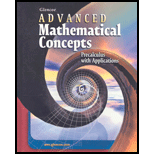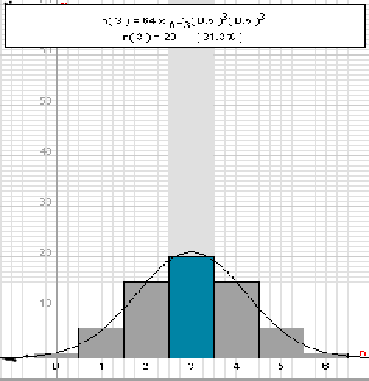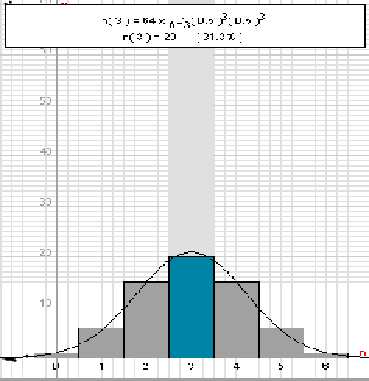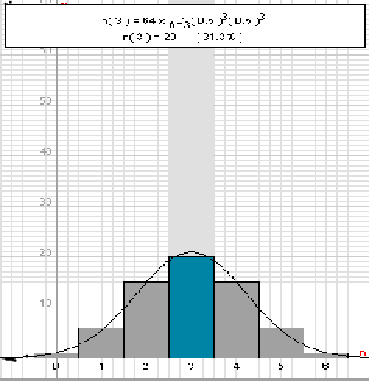
Concept explainers
(a)
To find:
The each probability of the given binomial experiments .
(a)
Answer to Problem 15E
The number of possibilities by the total number of possible outcomes
Explanation of Solution
Given:
The probability is of success is
The number of trials is
Concept used:
The distribution is a binomial distribution
P (k-success)
Calculation:
The distribution is a binomial distribution
The probability is of success is
The number of trials is
P (k-success)
The left side of the table
The probability of getting EXACTLY
The right side of the table is cumulative distribution
Binomial distribution
The number of possibilities by the total number of possible outcomes
(b)
To draw:
A bar graph and the experiment was repeated
(b)
Answer to Problem 15E
The number of possibilities by the total number of possible outcomes
Explanation of Solution
Given:
The probability is of success is
The number of trials is
Concept used:
The distribution is a binomial distribution
P (k-success)
Calculation:
The distribution is a binomial distribution
The probability is of success is
The number of trials is
P (k-success)
The number of possibilities by the total number of possible outcomes

(c)
A bar graph and the mean number of tails.
(c)
Answer to Problem 15E
The mean number of tails
Explanation of Solution
Given:
The probability is of success is
The number of trials is
Concept used:
The distribution is a binomial distribution
P (k-success)
Calculation:
The distribution is a binomial distribution
The probability is of success is
The number of trials is
P (k-success)
The number of possibilities by the total number of possible outcomes

The average number is the center peak of the probability distribution.
This is
(d)
To find:
The standard deviation of the number of tails.
(d)
Answer to Problem 15E
Explanation of Solution
Given:
The probability is of success is
The number of trials is
Concept used:
The distribution is a binomial distribution
P (k-success)
Calculation:
The distribution is a binomial distribution
The probability is of success is
The number of trials is
P (k-success)
The number of possibilities by the total number of possible outcomes

The equation for the standard deviation of a binomial distribution
Using these values in equation (1)
(e)
To draw:
A bar graph toa
(e)
Explanation of Solution
Given:
The probability is of success is
The number of trials is
Concept used:
The distribution is a binomial distribution
P (k-success)
Calculation:
The distribution is a binomial distribution
The probability is of success is
The number of trials is
P (k-success)
The number of possibilities by the total number of possible outcomes

A continuous normal distribution curve is overlaid on top of the discrete distribution.
Chapter 14 Solutions
Advanced Mathematical Concepts: Precalculus with Applications, Student Edition
Additional Math Textbook Solutions
Calculus: Early Transcendentals (3rd Edition)
University Calculus: Early Transcendentals (3rd Edition)
Single Variable Calculus: Early Transcendentals (2nd Edition) - Standalone book
Precalculus (10th Edition)
Calculus and Its Applications (11th Edition)
University Calculus: Early Transcendentals (4th Edition)
 Calculus: Early TranscendentalsCalculusISBN:9781285741550Author:James StewartPublisher:Cengage Learning
Calculus: Early TranscendentalsCalculusISBN:9781285741550Author:James StewartPublisher:Cengage Learning Thomas' Calculus (14th Edition)CalculusISBN:9780134438986Author:Joel R. Hass, Christopher E. Heil, Maurice D. WeirPublisher:PEARSON
Thomas' Calculus (14th Edition)CalculusISBN:9780134438986Author:Joel R. Hass, Christopher E. Heil, Maurice D. WeirPublisher:PEARSON Calculus: Early Transcendentals (3rd Edition)CalculusISBN:9780134763644Author:William L. Briggs, Lyle Cochran, Bernard Gillett, Eric SchulzPublisher:PEARSON
Calculus: Early Transcendentals (3rd Edition)CalculusISBN:9780134763644Author:William L. Briggs, Lyle Cochran, Bernard Gillett, Eric SchulzPublisher:PEARSON Calculus: Early TranscendentalsCalculusISBN:9781319050740Author:Jon Rogawski, Colin Adams, Robert FranzosaPublisher:W. H. Freeman
Calculus: Early TranscendentalsCalculusISBN:9781319050740Author:Jon Rogawski, Colin Adams, Robert FranzosaPublisher:W. H. Freeman
 Calculus: Early Transcendental FunctionsCalculusISBN:9781337552516Author:Ron Larson, Bruce H. EdwardsPublisher:Cengage Learning
Calculus: Early Transcendental FunctionsCalculusISBN:9781337552516Author:Ron Larson, Bruce H. EdwardsPublisher:Cengage Learning





